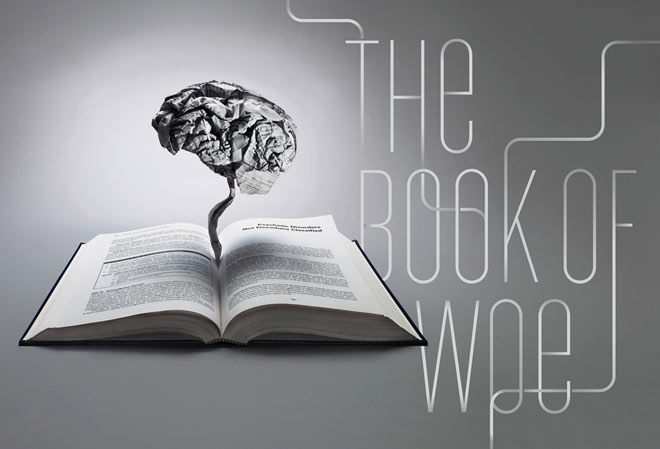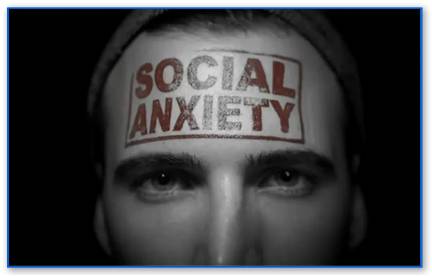By Kelly Patricia O’Meara
March 11, 2013

Photo: Garry Mcleod; Origami: Robert Lang – from Wired Magazine, “Inside the Battle to Define Mental Illness”
In 1952, the first hydrogen bomb was detonated and the American Psychiatric Association, APA, published its first book of mental illnesses: the Diagnostic and Statistical Manual of Mental Disorders, DSM.
No one, then, could have imagined that this seemingly innocuous manual would be more destructive, and result in producing more victims, than a nuclear weapon.
Since then the DSM has mushroomed and with each revised DSM untold millions carry the scars from its devastating effects.
Oddly enough, governments seem oblivious to the fallout of psychiatry’s arbitrary and devastating mental illness labels. Why? Could the answer lie in the extraordinarily profitable relationship between psychiatry and the pharmaceutical industrial complex?
The fact is pharmaceutical companies can’t push their latest mind-altering chemical concoctions until the deep-thinkers of psychiatry first vote the mental illness into existence. Then, unfortunately, the unsuspecting public becomes ground zero for these pharmaceutical Weapons of Mental Destruction (WMD).
How lucky, then, for the pharmaceutical industry. Very soon the APA will introduce its updated book of mental illnesses, the DSM-V. The APA’s latest book of behaviors it believes are abnormal actually may read longer than Leo Tolstoy’s War and Peace.
More importantly, though, according to recent reports, the newest book of mental disorders is not only horribly flawed but also is more dangerous than its previous version – the whopping 886-page DSM-IV-TR.
In fact, Allen J. Frances, M.D., former chairman of the APA’s DSM-IV Task Force and long-time cheerleader of the APA’s apparent philosophy of “we-can-find-a-mental illness-for-every-human-emotion,” now oddly has become an outspoken critic of the upcoming release of the DSM-V.
 Last year Frances published an op-ed in Psychology Today in which he slams the APA for approving “a deeply flawed DSM5 containing many changes that seem clearly unsafe and scientifically unsound.”
Last year Frances published an op-ed in Psychology Today in which he slams the APA for approving “a deeply flawed DSM5 containing many changes that seem clearly unsafe and scientifically unsound.”
The DSM-V is “unsafe and scientifically unsound?” Wow, Frances is just now figuring that out?! That cat long has been out of the bag and, no matter how the APA tries to spin it, psychiatric diagnosing is not now, nor has it ever been, based in science.
It is an important step, however, that the former chairman of the DSM Task Force is openly admitting that psychiatry’s diagnosing bible is “scientifically unsound.” But, Frances doesn’t stop there.
According to the psychiatrist, “the history of psychiatry is littered with fad diagnoses that in retrospect did far more harm than good.” Wow, there’s a confession!
One can only assume that it was only due to lack of space that Frances refrained from disclosing which “fad diagnoses” were more “harmful.” However, given that none of the diagnoses are based in science, Frances inadvertently raises a stunning point that lawmakers may want to explore.
For instance, since none of the alleged mental disorders are based in science, how does one determine which are “fads?”
 Nevertheless, it is Frances’ comments about the relationship between psychiatry and the pharmaceutical industry that finally reveal what the nation’s mental illness epidemic is all about.
Nevertheless, it is Frances’ comments about the relationship between psychiatry and the pharmaceutical industry that finally reveal what the nation’s mental illness epidemic is all about.
“New diagnoses in psychiatry,” says Frances, “are more dangerous than new drugs because they influence whether or not millions of people are placed on drugs…” Bada bing, bada boom! No diagnosis, no drugs. Yep, the APA first has to pull a disorder out of its…ear before the drugs can be prescribed.
Despite this glaring admission, the DSM-V will hit the streets in the Spring and, along with the old invented mental illness stand-bys, like depression, bipolar, ADD, ADHD and such, the APA will add many new mental disorders.
For instance, infant temper tantrums now are labeled as Disruptive Mood Dysregulation Disorder, normal grief becomes Major Depressive Disorder, forgetfulness in old age morphs into Minor Neurocognitive Disorder and excessive eating will now be diagnosed as Binge Eating Disorder.
Does anyone with a drug-free mind doubt that the pharmaceutical companies aren’t already preparing the newest line of mind-altering drugs to “treat” the newly invented mental disorders? And, for that matter, that the top drug pushers aren’t splitting their sides over the temper tantrum diagnosis?
Clearly the APA has yet to find a normal human emotion it can’t twist into a mental illness, and there’s little doubt that the pharmaceutical companies are biting at the bit to cash in on these newly invented labels. After all, peddling psychiatric mind-altering drugs is a booming business.
For example, between 2001 and 2010, the use of psychotropic drugs by adult Americans increased 22 percent, with one in five adults taking at least one mind-altering drug.
In 2010, alone, more than $16 billion dollars was spent on antipsychotics, $11 billion on antidepressants and $7 billion on ADHD drug “treatments.”
There is no doubt that with every revised edition of the DSM, always increasing the number of invented and utterly ridiculous mental illnesses, the pharmaceutical companies kept pace in creating magic mind-altering drugs for “treatment.”
In 2009, total U.S. prescription sales were $300 billion, with psychiatric mind-altering drugs accounting for half of those sales. And these data are based on drugs prescribed for the old stale diagnoses.
If the enormous sales from drugging kids diagnosed with the invented ADD/ADHD is any indication, one can only imagine the profits for the pharmaceutical companies from drugging toddlers whose temper tantrums are now labeled mental illness.
And in order to reap these enormous profits the pharmaceutical companies have to convince the public they’re needed as “treatment.” Between 1996-2005, the pharmaceutical industry tripled its direct-to-consumer advertising, making it easy to understand why today more than one in 10 Americans take antidepressants. Not surprising, antidepressants also happen to be the second most commonly prescribed drugs in the United States.
To add insult to injury the federal government, rather than question the lack of science behind the invented mental illnesses, actually contributes millions of dollars in grants to help develop psychiatry’s DSM—the very vehicle that allows the pharmaceutical companies to reap their enormous profits. In today’s debt-ridden economy, this is one government subsidy in desperate need of a furlough.
Worse still, the Food and Drug Administration (FDA), which is responsible for protecting the public against dangerous mind-altering drugs, is dominated by psychiatrists who shuttle between the drug industry, academia, private practice and government service—a virtual revolving door.
With an estimated 3,000 people dying from psychiatric drugs every month, a serious and immediate retaliatory response from lawmakers is required. The threat to the mental health of the nation can’t get any clearer than Frances’ conclusion that the “DSM 5 violates the most sacred (and most frequently ignored) tenet in medicine – First Do No Harm!”
—
Kelly Patricia O’Meara is an award winning investigative reporter for the Washington Times, Insight Magazine, penning dozens of articles exposing the fraud of psychiatric diagnosis and the dangers of the psychiatric drugs – including her ground-breaking 1999 cover story, Guns & Doses, exposing the link between psychiatric drugs and acts of senseless violence. She is also the author of the highly acclaimed book, Psyched Out: How Psychiatry Sells Mental Illness and Pushes Pills that Kill. Prior to working as an investigative journalist, O’Meara spent sixteen years on Capitol Hill as a congressional staffer to four Members of Congress. She holds a B.S. in Political Science from the University of Maryland.


SHARE YOUR STORY/COMMENT